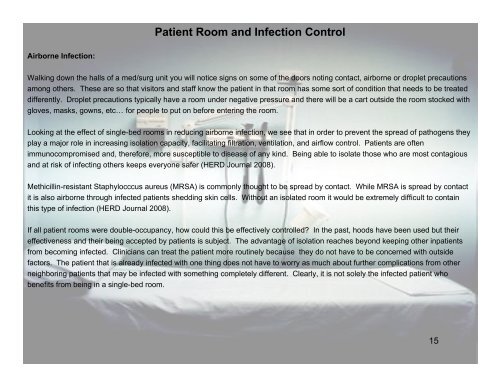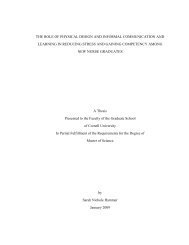The Patient Room: what is the ideal solution? - Cornell University
The Patient Room: what is the ideal solution? - Cornell University
The Patient Room: what is the ideal solution? - Cornell University
Create successful ePaper yourself
Turn your PDF publications into a flip-book with our unique Google optimized e-Paper software.
Airborne Infection:<br />
<strong>Patient</strong> <strong>Room</strong> and Infection Control<br />
Walking down <strong>the</strong> halls of a med/surg unit you will notice signs on some of <strong>the</strong> doors noting contact, airborne or droplet precautions<br />
among o<strong>the</strong>rs. <strong>The</strong>se are so that v<strong>is</strong>itors and staff know <strong>the</strong> patient in that room has some sort of condition that needs to be treated<br />
differently. Droplet precautions typically have a room under negative pressure and <strong>the</strong>re will be a cart outside <strong>the</strong> room stocked with<br />
gloves, masks, gowns, etc… for people to put on before entering <strong>the</strong> room.<br />
Looking at <strong>the</strong> effect of single-bed rooms in reducing airborne infection, we see that in order to prevent <strong>the</strong> spread of pathogens <strong>the</strong>y<br />
play a major role in increasing <strong>is</strong>olation capacity, facilitating filtration, ventilation, and airflow control. <strong>Patient</strong>s are often<br />
immunocomprom<strong>is</strong>ed and, <strong>the</strong>refore, more susceptible to d<strong>is</strong>ease of any kind. Being able to <strong>is</strong>olate those who are most contagious<br />
and at r<strong>is</strong>k of infecting o<strong>the</strong>rs keeps everyone safer (HERD Journal 2008).<br />
Methicillin-res<strong>is</strong>tant Staphylocccus aureus (MRSA) <strong>is</strong> commonly thought to be spread by contact. While MRSA <strong>is</strong> spread by contact<br />
it <strong>is</strong> also airborne through infected patients shedding skin cells. Without an <strong>is</strong>olated room it would be extremely difficult to contain<br />
th<strong>is</strong> type of infection (HERD Journal 2008).<br />
If all patient rooms were double-occupancy, how could th<strong>is</strong> be effectively controlled? In <strong>the</strong> past, hoods have been used but <strong>the</strong>ir<br />
effectiveness and <strong>the</strong>ir being accepted by patients <strong>is</strong> subject. <strong>The</strong> advantage of <strong>is</strong>olation reaches beyond keeping o<strong>the</strong>r inpatients<br />
from becoming infected. Clinicians can treat <strong>the</strong> patient more routinely because <strong>the</strong>y do not have to be concerned with outside<br />
factors. <strong>The</strong> patient that <strong>is</strong> already infected with one thing does not have to worry as much about fur<strong>the</strong>r complications from o<strong>the</strong>r<br />
neighboring patients that may be infected with something completely different. Clearly, it <strong>is</strong> not solely <strong>the</strong> infected patient who<br />
benefits from being in a single-bed room.<br />
15







